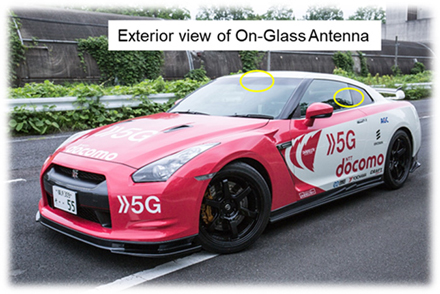|
Nippon Telegraph and Telephone (NTT) DOCOMO, Asahi Glass Company (AGC Inc.), and Ericsson have teamed up to demonstrate the performance of 5G and the novel use of glass-mounted antennas on vehicles traveling at high speeds.
Using glass-mounted antennas (also referred to as on-glass antennas) during a 5G field trail on 24 July 2018, the three partners achieved a communication speed of 8 Gb/s with a vehicle traveling at approximately 100 km/h.

The 5G 28-GHz, band-compatible on-glass antennas used in the field trial were designed and developed by Japanese glass manufacturer AGC, Inc. The on-glass antennas are not easily seen from the exterior and can be installed on glass surfaces with no negative impact on the vehicle design.
Because radio waves in the 28-GHz frequency band suffer from large propagation losses, 5G radio waves face difficulties when traveling long distances.
By installing an on-glass antenna on a vehicle, 5G radio waves can be transmitted and received using beamforming, a technique that concentrates radio waves in a specific direction in combination with MIMO techniques, which improves the communication speed by simultaneously transmitting different data from multiple antennas. This allows stable, high-speed communication, even for vehicles in operation.
For this field trial, 5G high-speed communications using both the beamforming function and the MIMO function were performed on a vehicle equipped with on-glass antennas. The trial was held at the National Institute for Land and Infrastructure Management in Ibaraki Prefecture, Japan.
While the vehicle traveled at approximately 100 km/h, a maximum communication speed of 8 Gb/s was achieved, and a maximum of 11 Gb/s was achieved at a vehicular speed of approximately 30 km/h. This trial confirmed that high-speed in-vehicle communications in the 28-GHz band can be achieved by using on-glass antennas.
NTT DOCOMO, AGC, and Ericsson will continue working toward using 5G in various environments, including in-vehicle communication modules, and hope to see 5G-connected cars become a reality.
Full article: IEEE Vehicular Technology Magazine, Volume 13, Number 4, December 2018 |